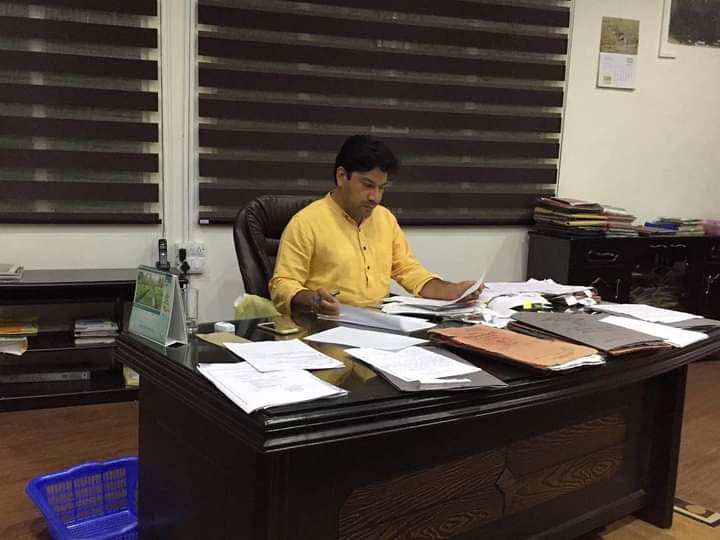Of late, there has been a spurt in wildlife smugglers getting caught at airports while trying to smuggle out or smuggle in live animals or body parts. News of recovery of pangolins in airports have been doing the rounds. As such, another piece of news – that of the launch of an awareness and capacity building tool, developed under the project, Deterring and Disrupting Wildlife Trafficking in the Air Transport Sector in India, on 25 March at National Academy of Customs, Indirect Taxes & Narcotics (NACIN), Faridabad – came just in time, and as a relief.
The tool includes two online courses on how to curb wildlife trafficking and relevant laws and regulations, an informative video highlighting wildlife trafficking through airports, checklists for enforcement officials to use in their day-to-day operations, also posters and standees offering vital information about commonly trafficked wildlife species.
Indian Masterminds spoke to Indian Forest Services (IFS) officer Dr. Saket Badola on the importance of this tool, which primarily focuses on skilling and providing knowledge to the officials who face these crimes on a day-to-day basis. Mr. Badola is currently the Head of TRAFFIC’S India office, which played a key role in developing the tool. TRAFFIC, the Wildlife Trade Monitoring Network, is a non-governmental organisation working globally on the trade in wild animals and plants.
AIPORTS POPULAR MODE FOR TRAFFICKERS
According to TRAFFIC’s HIGH FLYING: Insight into Wildlife Trafficking through India’s Airports analysis, between 2011-2020, trafficking of over 70,000 native and exotic wild animals, including their body parts or derivatives (weighing around 4000kg), were detected in 141 wildlife seizure incidents at 18 Indian airports. Forty-six per cent of seizures were reptiles, including the vulnerable Indian Star Tortoise, with traffickers clearly disregarding the international rules prohibiting its trade to protect the species. The Indian Star Tortoise is listed as vulnerable on the IUCN Red List and in Appendix I of the Convention on International Trade in Endangered Species of Wild Fauna and Flora (CITES), prohibiting its trade.
Besides this, the seizures also included 18% mammals, 13% timber, and 10% from the marine species. Not only the Indian tortoise but Black Pond Turtle, Red-Eared Slider Turtle were primarily found in those seizures.
Dr. Saket Badola emphasised that the analysis doesn’t represent the actual picture, as most of the illegal wildlife trade go unchecked and unreported. He said, “TRAFFIC’s study of wildlife seizures at Indian airports between 2011-2020 reinstates the need to strengthen enforcement efforts to curb the exploitation of the airline sector for conducting illegal wildlife trade.”

TRAFFIC and UNEP (United Nations Environment Programme) in collaboration with WCCB (Wildlife Crime Control Bureau) and WWF-India launched a first-of-its-kind project in India focused on working with enforcement officials to detect and deter wildlife trafficking through airports.
Ms. Tilotama Varma, Additional Director, WCCB, said, “Airports have emerged as a popular mode for transporting wildlife contrabands due to the shorter travel time and extensive reach. Traffickers smuggle wildlife and their derivatives through checked-in luggage and personal baggage, by concealment of wildlife contraband within passenger clothing, footwear, and other wearables and through the wrong declaration of protected species, all of which makes detection cumbersome for enforcement agencies. The newly developed resources under the project will prove useful for bridging such gaps.”
ABOUT THE TOOL
The new awareness and capacity building tool developed under the project – Deterring and Disrupting Wildlife Trafficking in the Air Transport Sector in India – was launched at an event on 25 March 2022 at NACIN (National Academy of Customs, Indirect Taxes & Narcotics), Faridabad.
The tool includes two online courses on how to curb wildlife trafficking and relevant laws and regulations, an informative video highlighting wildlife trafficking through airports, checklists for enforcement officials to use in their day-to-day operations, also posters and standees offering vital information about commonly trafficked wildlife species.
To utilise the coming together of agencies, the launch event also included a training programme, where over 40 officials from various NACIN academies across India, Customs, CISF (Central Industrial Security Force), WCCB, and partner organisations physically attended and also joined through online mode.
This tool is accessible via a new online knowledge hub (www.IWTKnowledgeHub.in).
Mr. Yogendra Garg, Additional Director General, NACIN, said, “Customs need to continuously acquire new skills to keep pace with the latest trends in smuggling. Training tools and resources are thus crucial for upscaling their skills to detect crime. Also, there is a dire need to create awareness about emerging issues like wildlife crime from time to time. We, at NACIN, are really glad that a dedicated effort for curbing wildlife trafficking through airports has been initiated through this project.”
Stressing on how wildlife needs support due to the threats by human interventions, the officials associated with the project said that the new project will not only engage with nodal agencies at airports but, also, help to increase the awareness and prevention of illegal wildlife trade.

































